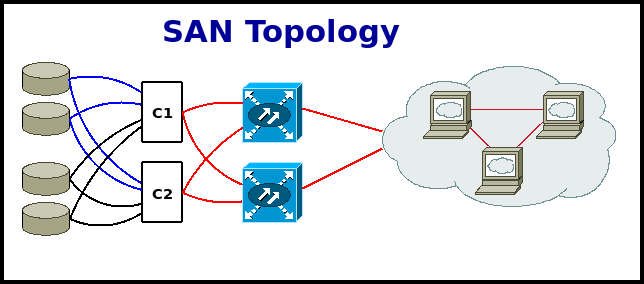What is going on in the industry and what is the relevance?
For the past ~20 years, most Enterprise environments have ran on the premise of hosting most of their storage in a centralized storage array and then connect to it over a dedicated Storage Area Network (SAN) in order to gain access to their data. With these types of environments costs tend to be high but the reliability and performance that these systems provided have been worth the cost. Starting (mainly) in the late 90’s, arrays were originally connected to mainframes but eventually spread to every piece of capable hardware in an enterprise environment. Many people, myself included, made a great career off of these environments and provided value to their organizations by keeping infrastructure running quickly and assisting revenue generating applications with said hardware.

But in the past couple years, things have been changing. No longer are we in a state of enterprise IT where Infrastructure can easily bring value to an organization. Gone are the days of reducing latency by 80%; All Flash Arrays (AFAs) have been a thing for years. Gone are the days of saving costs by overprovisioning; Thin allocations have been around for years. Fast != an automatic win anymore, so what are we to do?
The Application is King
Online Banking. Online Insurance Quotes. Big Data Analytics. Cloud scalable applications. These applications, amongst countless others, are what builds the business around what IT provides as their service. Can all of these applications benefit from fast storage access? Sure, but it’s a marginal gain at this point. So, what can the market provide to these application owners and developers that can make them love their operations teams once again?

Focusing on the application, not only as a service or piece of software, but as a process is where we can provide value with new storage environments. Software defined storage (SDS) in particular is interesting in this regard. Like most new software platforms and enterprise IT products, SDS is built natively with API’s and integration in mind. SDS also natively brings other aspects of new IT, specifically being built on commodity hardware, letting the software do most of the heavy lifting. So how do we incorporate these features, or more directly, how is this all that different from what we’ve done in the past?
If we simply allocate storage to an application from an SDS platform, we’re just kicking the can down the road and not truly innovating. What SDS can provide us that’s innovative is the ability for an application to quickly access or allocate its own storage whenever they deem it necessary. With API’s and other orchestration and automation tools, we can leverage easily allocatable storage by simply building the workflows around it allowing anyone (that we allow access) to grant their own storage. Like a previous mentor of mine once told me, “Try and automate the easy things so your smart employess can keep doing smart things”. This message is still true today; let your app owners access their own storage so you can provide value somewhere else.
Why SDS? Aren’t there other options?
Absolutely! There are many options that can attack this dilemma from a technical aspect. Where I think SDS shines is in its flexible architecture that doesn’t sacrifice performance (some caveats, but true for the most part) and can be purchased in an as needed fashion in incremental amounts. The latter part of that statement is traditionally overlooked, but is quite important.
SIDE BAR! I’ve had the luxury of working for a technology company multiple times, but most people using storage technologies aren’t in that line of business. If you work at Aunt Mary’s Bank of Nevada (totally made up) in their IT department, you don’t work in technology, you work in the technology department for a financial institution. The key difference is that the products you use and maintain should somehow help the end business and if we can keep that in mind, then we can be a substantial value to an organization. How does this tie to SDS? SDS allows users to buy in small increments and treat each “node” as its own asset. From a financial focus, we’re now able to not overbuy, to forecast our spend more accurately and give money back to the business to do what your company does best outside of IT. Truly a value add outside of technology itself.
With the changing landscape of storage, I think that we’re getting to the point where the SDS options and Hyperconverged infrastructures are finally making financial and business sense. Infrastructure isn’t as sexy as it used to be in IT but it still can hold value if the right goals are kept in mind.